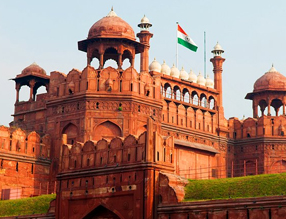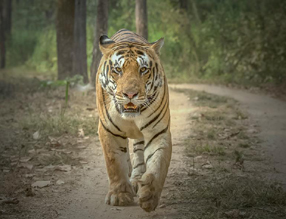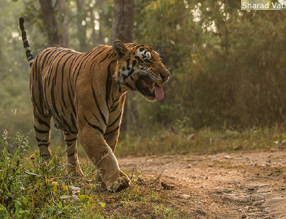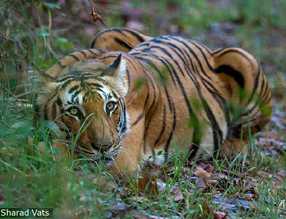Duration: 15 Nights / 16 Days
Place to visit: New Delhi – Nagpur – Tadoba - Pench – Kanha – Bandhavgarh – Panna - Khajuraho – New Delhi Fly Back Home
 Day 01: Arrive New Delhi
Day 01: Arrive New Delhi
On arrival at the New Delhi airport, you will be met by our representative who will transfer you and assist you in check in at the hotel. He will handover and explain all the travel related documents.
Overnight stay at the hotel in New Delhi.
Day 02: New Delhi – Nagpur – Tadoba (by surface 100 kms/2 hrs drive + flight)
Transfer to the airport in the morning to board a flight at 0610 hrs to arrive Nagpur at 0750 hrs. Met at the airport at 0750 hrs and drive to Tadoba National Park 100 kms / 2 hours drive. On arrival check into the Resort. Lunch and then depart for afternoon Jeep safari to the National park.
Dinner and overnight stay at the resort in Tadoba
Day 03: In Tadoba
Breakfast and lunch at the Resort. Morning and afternoon Jeep safaris to the National park
Tadoba Tiger Reserve is a rare jungle jewel amongst India’s leading tiger reserves and national parks. It is affably called the Land of the Tigers, due to its high tiger density. Recent estimates indicate around 64 tigers over a rich jungle spread over 625 square kilometers. Visitors report frequent Tiger and wild dog sightings. In general, the park offers plenty of opportunities for close encounters of the wildlife kind which also include: Leopard, Sloth Bear, Gaur (Indian Bison), Rusty Spotted Cat, Ratel, Indian Mouse Deer, Spotted Deer, Sambar, Wild Pig, Four Horned Antelope, Flying Squirrel, and more. Over 195 species of birds include the crested serpent eagle, honey buzzard, paradise flycatcher, grey-headed fishing eagle, the shy jungle fowl, and much more.
Dinner and overnight at the Resort.
Day 04: In Tadoba
Breakfast and lunch at the Resort. Morning and afternoon Jeep safaris to the National park.
Densely forested hills form the northern and western boundary of the tiger reserve. The
elevation of the hills ranges from 200 m (660 ft) to350 m (1,150 ft). To the southwest is the 120
ha (300 acres) Tadoba lake which acts as a buffer between the park’s forest and the extensive
farmland which extends up to Irai water reservoir. This lake is a perennial water source which
offers good habitat for Muggar crocodiles to thrive. Other wetland areas within the reserve
include the Kolsa lake and Andhari river.
Tadoba reserve covers the Chimur Hills, and the Andhari sanctuary covers Moharli and Kolsa ranges. It’s bounded on the northern and the western side by densely forested hills. Thick forests are relieved by smooth meadows and deep valleys as the terrain slopes from north to south. Cliffs, talus and caves provide refuge for several animals. The two forested rectangles are formed of Tadoba and Andhari range. The south part of the park is less hilly.
Dinner and overnight at the Resort.
Day 05: Tadoba – Pench ( By road 200/ 5 hrs drive
After breakfast drive to the national park and later drive to Pench National Park 200 kms / 5 hours drive. On arrival check into the Resort. Lunch at resort and afternoon game drive to the national park
Dinner and overnight stay at the resort.
Day 06: In Pench
 Morning and afternoon Jeep safari to the National park. Meals and overnight at the resort.
Morning and afternoon Jeep safari to the National park. Meals and overnight at the resort.
Pench is located between four different mountain ranges - Aravali, Vindhyanchal, Satpura and Maikal. The tracks are smoother, the trees are thicker with dense undergrowth, perhaps one reason why the herbivore population here is larger in size compared to Kanha and Bandhavgarh.
Pench National Park, nestling in the lower southern reaches of the Satpura hills is named after Pench River which flows from north to south through the Pench National Park. It is located on the southern boundary of Madhya Pradesh.
A total of 758 Sq. kms of this Southern Indian tropical moist deciduous forest has its extent mingling with the tropical dry deciduous teak. The area is crisscrossed by a number of streams and 'nallahs' most of which are seasonal. Though the Pench River dries up in April end, a number of water pools locally known as 'dohs' are found which serve as water holes for the wild animals. The Pench Reservoir at the center of the park is the only major water source during the pinch period.
As a prey concentration is high along the Pench River, tiger usually inhabits and frequents this belt. Leopards though generally operate in the peripheral areas but are occasionally seen in the deep forest also. Jungle cats are commonly seen. Leopard cats, small Indian civets and palm civets are seen rarely.
In Pench, Cheetal, Sambar, are commonly seen grazing on the open sites on roadsides and banks of river & reservoir. Jackals can be seen in search of food anywhere in the Park. Packs of upto 15 or more wild dog can be seen near Chhedia, Jamtara, Bodanala and Pyorthadi areas of the Reserve. Herds of gaur can be spotted near streams and bamboo patches commonly in summer months. Sloth beer occupy the rocky areas and favour mahul bel infested forest. Chinkara is present in very small numbers and is found in open areas around Turia, Telia and Dudhgaon villages.
Dinner and overnight stay at Pench.
Day 07: Pench – Kanha (210 kms /4-5 hrs drive)
After breakfast drive to Kanha national park 210 kms/ 5 hour drive. On arrival check into the Resort. Lunch at resort and afternoon game drive to the national park. Dinner and overnight at the resort in Kanha.
Day 08: In Kanha
Wake up at 0500hrs, tea coffee with biscuits, and proceed for the morning safari to the National park.
 Kanha's sal and bamboo forests, rolling grasslands and meandering streams stretch over 940 sq km in dramatic natural splendor which form the core of the Kanha Tiger Reserve created in 1974 under Project Tiger. The park is the only habitat of the rare hardground Barasingha (Cervus Duvaceli Branderi).
Kanha's sal and bamboo forests, rolling grasslands and meandering streams stretch over 940 sq km in dramatic natural splendor which form the core of the Kanha Tiger Reserve created in 1974 under Project Tiger. The park is the only habitat of the rare hardground Barasingha (Cervus Duvaceli Branderi).
This is the original Kipling country of which he wrote so vividly in his Jungle Book. Packed breakfast which comes from the Lodge is served at a designated spot and spread on the bonnet of the Safari vehicle. Enjoy your breakfast in the wilderness of Kanha.
Continue your search for the elusive Tiger if you have not yet seen the same, and soak in the fresh, and energizing environment. Return from Safari around 1130hrs. Freshen up, and Lunch is served.
Depart for evening jeep safari Kanha National Park. Return at 6pm from safari. Dinner and overnight at the Lodge. Dinner and overnight at the Lodge.
Day 09: In Kanha
Wake up, and get ready for another day of adventure in the National park. The forests of the Banjar valley and Halon valley, respectively forming Kanha's western and eastern halves. By a special statute in 1955, Kanha National Park came into being. Since then, a string of stringent conservation programmes have been launched, for the overall protection of the park's fauna and flora. Kanha boasts of about 38 species of mammals. Some of the inhabitants of this park are the gaur, the largest of the world's cattle; the sambar, the largest Indian deer; and the chausingha, the only four-horned antelope in the world. Other frequent visitors include the Nilgai antelope, the sloth bear, the dhole, or Indian wild dog, and an occasional Leopard. Some 300 species of birds inhabit the park, that includes the storks, egrets, black ibis, raptors, owls, and the red-wattled lapwings.
Depart for evening jeep safari Kanha National Park. Return at 6pm from safari. Dinner and overnight at the Lodge.
Day 10: Kanha – Bandhavgarh (by surface 280 kms/6 hrs drive )
Morning breakfast and depart for Bandhavgarh, 280kms, 6 hours drive. On arrival check into the Lodge. Lunch, afternoon safari. Dinner and overnight at the Lodge.
Day 11: In Bandhavgarh
Breakfast, Lunch and Dinner at the Resort. Morning Jeep drives in the park
Bandhavgarh: The national park is mainly known for the density of its tiger population. The other wild attractions in the park include Leopards, Blue Bulls, Indian Gaur (Bison) Chausingha (Four Horned Antelopes), Spotted Deers, Sambar Deer, Wild Boar, Sloth Bears Fox, Jackals, Wild Dogs, etc. There are at least 22 mammal species and about 250 bird species in the Park. The other animals found in Bandhavgarh are Ratel, Porcupine, Small Indian Civet, Palm Squirrel, Lesser Bandicoot rat, the Jungle Cat, and the shy Hyenas. The reptile population in the park includes Cobras, Kraits, Vipers, Ratsnakes, Pythons, Monitor Lizards and turtles. The two primate species - the rhesus macaque and the Hanuman langur - inhabit Bandhavgarh.
Dinner and overnight at the Resort
Day 12: In Bandhavgarh
Breakfast, Lunch and Dinner at the Resort. Morning & evening Jeep drives in the park.
Bandhavgarh has been a center of human activity and settlement for over 2000 years, and there are references to it in the ancient books, the Narad-Panch Ratra and the Shiva Purana.
The oldest sign of habitation in the park are caves dug into the sandstone to the north of the fort. Several contain Brahmi inscriptions dating from the 1st century B.C. Various dynasties have ruled the fort, for example, the Maghas from the 1st century A.D., the Vakatakas from the 3rd century A.D. From that time onwards Bandhavgarh was ruled by a succession of dynasties including the Chandela Kings.
Bandhavgarh became more and more deserted until forest overran the area band it became the royal hunting reserve. At independence Bandhavgarh remained the private property of the Maharaja until he gave it to the state for the formation of the National Park in 1968. After the park was created poaching and hunting was brought under control and the number of animals rose dramatically. The Tigers in particular prospered and the 1986 extension provided much needed forest to accommodate them.
Overnight at the resort.
 Day 13: Bandhavgarh – Panna (by surface 240 kms/5 hrs drive )
Day 13: Bandhavgarh – Panna (by surface 240 kms/5 hrs drive )
Morning game drive to the national park. After early lunch drive to Panna national park 240 kms/5 hrs drive. On arrival check into lodge. Panna Tiger Reserve, known for its tigers and leopards, as well as its hyenas and wolves. Dinner and overnight at the Lodge.
Day 14: In Panna
Breakfast, Lunch and Dinner at the Lodge. Morning & Evening Jeep drive in the park. Overnight In resort Panna is situated in the Vindhya Hill range and spreads over the Panna and Chhatarpur districts in the northern part of Madhya Pradesh. Panna National Park is the most important protected area in the north-central highlands of India,Panna National Park is located along the banks of the Ken River. The Park, with its deep ravines, cascading waterfalls and thick teak forests, is predominantly a plateau, with sprawling flatlands punctuated by hills, deep valleys and gorges. The terrain is largely rocky and uneven. There are mixed dry deciduous forests with short grasses and open woods. Panna is home of majestic tiger, including leopard, wolf, hyena, jackal and sloth bear. The reserve is also well known for sightings of nilgai, sambar, chital, wild boar and Indian crocodile.
Day 15: Panna - Khajuraho – New Delhi Fly back home
Morning a boat ride at Ken river to find Gharials. A separate sanctuary for Gharial has been set up. The park can probably boast of the highest density of the Paradise Fly-Catchers. This rich avian and faunal life combined with its picturesque scenery make a visit to the Park a memorable. After lunch drive to Khajuraho 40 kms/1 hrs to board a flight to New Delhi at 1550 hrs. Arrive New Delhi at 1830 hrs. Met at airport and transfer hotel. Overnight stay at the hotel in New Delhi
Day 16: New Delhi Fly back home
Morning free for leisure activities and later transfer to International airport to board a flight back home or onward destination
